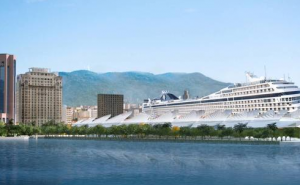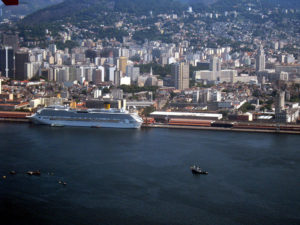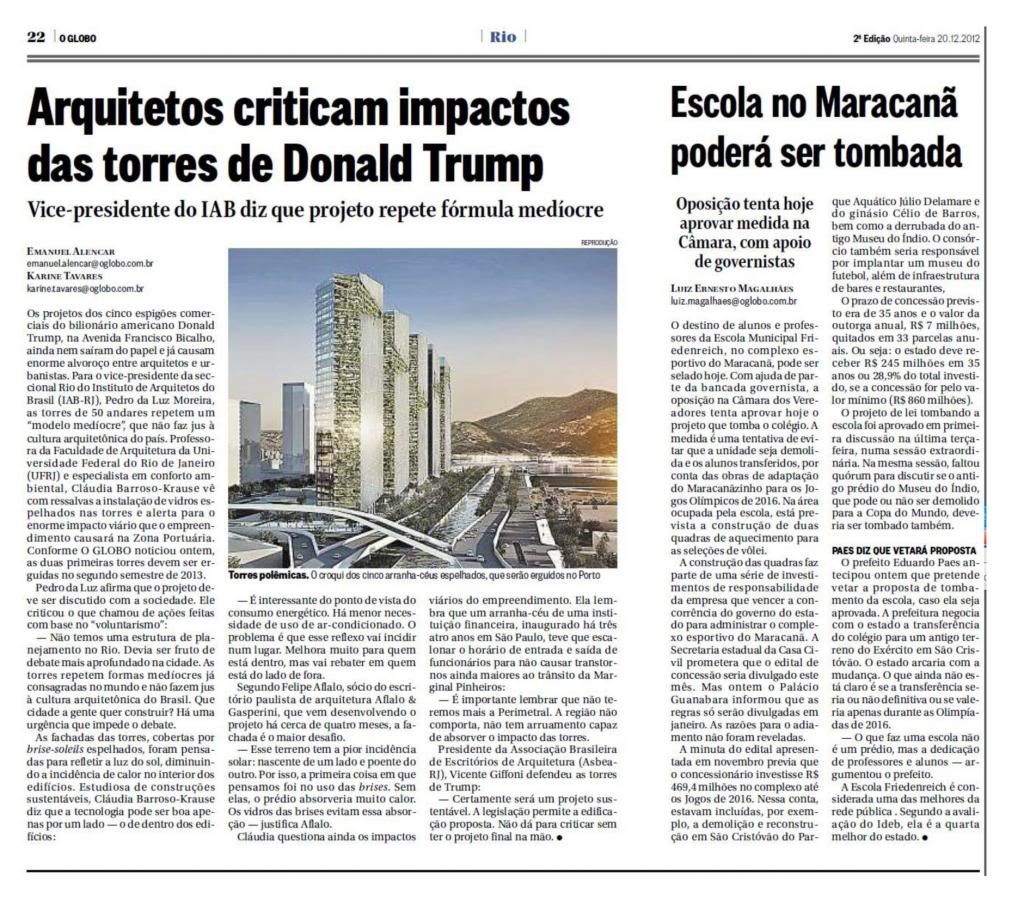Clique na imagem para ampliar.
Imprensa
Arquitetos criticam impacto das torres de Donald Trump
Arquitetos criticam impactos das torres de Donald Trump

Emanuel Alencar
Karine Tavares
RIO – Os projetos dos cinco espigões comerciais do bilionário americano Donald Trump, na Avenida Francisco Bicalho, ainda nem saíram do papel e já causam enorme alvoroço entre arquitetos e urbanistas. Para o vice-presidente da seccional do Rio do Insituto de Aquitetos do Brasil (IAB-RJ), Pedro da Luz Moreira, as torres de 50 andares repetem um “modelo medíocre”, que não faz jus à cultura arquitetônica do país. Professora Faculdade de Arquitetura da Universidade Federal do Rio de Janeiro (UFRJ), e especialista em conforto ambiental, Cláudia Barroso-Krause vê com ressalvas a instalação de vidros espelhados nas torres e alerta para o enorme impacto viário que o empreendimento tará à Zona Portuária. Conforme O GLOBO noticiou ontem, as duas primeiras torres devem ser erguidas no segundo semestre de 2013.
Pedro da Luz afirma que o projeto deve ser discutido com a sociedade. Ele criticou o que chamou de ações feitas com base no “voluntarismo”:
— Não temos uma estrutura de planejamento no Rio. Devia ser fruto de debate mais aprofundado na cidade. As torres repetem formas medíocres já consagradas no mundo e não fazem jus à cultura arquitetônica do Brasil. Que cidade a gente quer construir? Há uma urgência que impede o debate.
As fachadas das torres, cobertas por brise-soleils espelhados, foram pensadas para refletir a luz do sol, diminuindo a incidência de calor no interior dos edifícios. Estudiosa em construções sustentáveis, Cláudia Barroso-Krause diz que a tecnologia pode ser boa apenas por um lado — o de dentro dos edifícios:
— É interessante do ponto de vista do consumo energético. Há menor necessidade de uso de ar-condicionado. O problema é que este reflexo vai incidir num lugar. Melhora muito para quem está dentro, mas vai rebater em quem está do lado de fora.
Segundo Felipe Aflalo, sócio do escritório paulista de arquitetura Aflalo & Gasperini, que vem desenvolvendo o projeto há cerca de quatro meses, a fachada é o maior desafio.
— Esse terreno tem a pior incidência solar: nascente de um lado e poente do outro. Por isso, a primeira coisa em que pensamos foi no uso das brises. Sem elas, o prédio absorveria muito calor. Os vidros das brises evitam essa absorção — justifica Aflalo.
Cláudia questiona ainda os impactos viários do empreendimento. Ela lembra que um arranha-céu de uma instituição financeira, inaugurado há três atro anos em São Paulo, teve que escalonar o horário de entrada de saída de funcionários para não causar transtornos ainda maiores ao trânsito da Marginal Pinheiros.
— É importante lembrar que não teremos mais a Perimetral. A região não comporta, não tem arruamento capaz de absorver o impacto das torres.
Presidente da Associação Brasileira de Escritórios de Arquitetura (Asbea-RJ), Vicente Giffoni, defendeu as torres de Trump:
— Certamente será um projeto sustentável. A legislação permite a edificação proposta. Não dá para criticar sem ter o projeto final na mão.
Jornal O GLOBO – RIO
Controversy Over Y Pier in Port Zone
By Chesney Hearst, Contributing Reporter
RIO DE JANEIRO, BRAZIL – The proposed location for a new Y shaped pier capable of docking six massive cruise ships is causing waves of controversy in the city’s Port Zone. The alarm is over the aesthetic impact to the new culture and tourism hub in Rio, versus the logistics of the construction.

A simulation of how the new Museum of Tomorrow will look overshadowed by a large cruse ship in Rio’s Port Zone, image Divulgação.
While development and renovations are ongoing in many areas of Rio, in preparation for the upcoming2014 World Cup and 2016 Olympics, the question of visitor accommodations once the events begin remains an issue.
One proposed solution suggests hosting some guests in cruise ships. However, the slated location site for additional docks, has drawn criticism from many city residents.
Currently Pier Mauá in Rio’s Port Zone is the port of call for cruise ships docking in Rio de Janeiro. The area in front of Armazém 6 – one of the historic former warehouses that flank the port – was originally slated as the construction site for the new Y shaped pier.
The Companhia Docas do Rio de Janeiro (Dock Company of Rio de Janeiro) shifted the future site to an area between Armazém 2 and 3, making the new pier only 500 meters from the future Museu do Amanhã, (Musuem of Tommorow).
Critics have stated that the new location of the pier with six large cruise ships – that can reach up to seventy meters tall, will overshadow the museum and obstruct the view of the Monasterio de Sao Bento. “The location is wrong. The [Companhia Docas] decided based only technical data,” President of AsBEA/RJ (The Brazilian Association of Architecture Firms in Rio de Janeiro), Vicente Giffoni told The Rio Times.

Cruise ship Costa Serena docked at Rio’s Pier Maua, photo by Jorge Andrade/Wikipedia Creative Commons License.
“You have to listen and understand what’s going on in the city when you are dealing with such a large development that will have such a big impact,” Giffoni explained.
A once almost forgotten area of the city, The Port Zone,has undergone major urban regeneration during the last two years through a project entitled, Porto Maravilha (Wonderful Port). The large scale developments of the project spread across an area of five million square meters that stretches between Avenues Presidente Vargas, Rodrigues Alves, Rio Branco and Francisco Bicalho.
The neighborhoods included in the area are seeing renovations that aim to enhance future commercial and residential appeal. Also, a 4km, six lane underground expressway tunnel is under construction in the hopes of easing future traffic in the region.
Two cultural additions are also planned for the area: the Museu de Arte do Rio de Janeiro (The Museum of Art) and the previously mentioned Museum of Tomorrow designed by Spanish architect Santiago Calatrava.
“Having a design by a genius of architecture [Calatrava] being hidden by ships is totally absurd,” José Conde Caldas, President of the Association of Directors of Companies in the Real Estate Market (Ademi-RJ) recently told O Globo. “The Porto Maravilha project came from strength to strength until this pier, which looks more like a piano in the middle of the room.”
The Companhia Docas President defended their proposal telling the press, “There are navigation channels in the bay, which are like avenues. If the pier was by Armazém warehouses 5 and 6, the channel would have to be shifted more yards. With the pier in Armázem 2, the channel will be moved with less hassle and less cost. It does not disturb the view of the Monasterio [de Sao Bento].”
At the time of this report, construction of the Y Pier is slated to begin in 2013. “It won’t happen in that place. I’m almost sure this will not happen. It’s incredible how large the consensus is against it,” concluded Giffoni.


